Fast Forward
Former Iowa Writers’ Workshop instructor, author, and social critic Kurt Vonnegut once stirred public imagination by proposing a presidential cabinet that included a secretary of the future, wholly dedicated to formulating plans that would benefit coming generations.
While Vonnegut’s idea hasn’t taken flight in Washington, UI researchers from across disciplines work daily in that spirit to fuel innovations that will shape our future. Driverless cars, robotic personal assistants, organ regeneration—concepts that once existed only in science fiction are inching closer to everyday reality with each new discovery. Such advances will transform every aspect of our lives, including the ways we learn, work, and relax.
Iowa Alumni Magazine recently asked 18 UI faculty, staff, and students to envision what’s to come in their fields decades from now. Here are their bold predictions for tomorrow.
TRAVEL

Dan McGehee, director of the National Advanced Driving Simulator at the UI, explains the advances made toward a future with self-driving electric vehicles.
Land: Hands Off the Wheel
When I first came to the UI in 1993 as part of the original Iowa Driving Simulator project, some of our first studies were on forward-collision warning, lane keeping, and adaptive cruise control. Those technologies would become the fundamental building blocks of the higher levels of automation we see today and into the future.
This year we’re beginning our first naturalistic driving study of higher levels of automation with our Tesla Model S research vehicle. We’ll lend the Tesla for a week to regular I-380 road users and record how they perform using more advanced driver assistance systems, like autopilot. Tesla’s autopilot system uses a computer vision and radar system to see the lane lines and gauge the distance to the car ahead. It brakes, accelerates, and steers itself, but requires you grasp the steering wheel every so often.
This spring we’ll also begin working with a Lincoln MKZ research prototype being specially constructed for us that can ingest a high-definition map we’re developing for the I-380 corridor. Right now, your phone or GPS is accurate to plus or minus 1 meter, which is not good enough for us to reliably understand where we are on the road. High-definition maps like the one we’re creating will get that down to plus or minus 7 centimeters. We’ll need a new Eisenhower freeway network— digital roadways mapped to high-definition levels—for our next generation of driving.
Looking 50 years into the future, we’ll see automated ride hailing. It might not be commonplace, but it will be available in urban areas. These vehicles, once in roving mode, won’t need to park other than to recharge, so we’ll be able to eliminate many parking ramps. In the long-term future, we’ll design narrower roads because these cars will be so accurate.
Our future vehicles will be electric. Companies like Volvo have already announced that within a few years they will no longer make a fully gas- or diesel-powered engine. Hybrids will be the only vehicles they offer with internal combustion engines, and the rest will be electric. GM and Ford have also announced phase outs of fully internal combustion engines, so by 2030, we’ll see hybrids as the majority of cars sold.
DAN MCGEHEE
Director of the National Advanced Driving Simulator and associate
professor of mechanical and industrial engineering, emergency
medicine, public health, and public policy
Air: Hitch a Ride in the Sky
In the next 40 years, we’ll have more unmanned aircraft, and manned aircraft will be largely automated. The UI Operator Performance Laboratory is actually working on a mask for pilots similar to the one in the Iron Man movies, where the pilot sees augmented reality overlays that annotate obstacles, objective areas, alerts, and threats. It looks easy in the movies, but in reality, it’s hard to do.
In the future, smaller quantities of travelers will be flown in a more targeted way. You will hail an aircraft like an Uber to take you to your destination by ride-sharing with others.
There’s a lot of hype about unmanned aircraft where you could hail a ride on your iPhone and a helicopter picks you up on the Ped Mall. That just can’t happen. Even if it’s electric, it will be loud. To elevate four people, you’d be blowing baby strollers out of the Ped Mall for a quartermile around. Reality is going to involve helipads at the most, but more likely it’s smarter to use the 10,000 small airports that we have in the United States.
TOM SCHNELL
Director of the Operator Performance Laboratory and professor of industrial engineering
Space: Colonizing the Stars
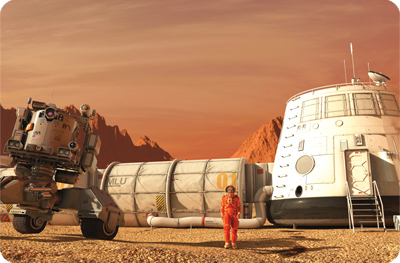 An artist’s rendering
of life on Mars
An artist’s rendering
of life on Mars
The biggest trend in space exploration is the rise of private companies developing rockets and other technologies to exploit space. The first launch of a privately developed rocket was by SpaceX in 2009, and in 2018 there may be more launches by private companies than by governments. Commercialization will really take off when people figure out how to make money in space.
Colonizing Mars is often taken as the first step in moving humans off planet Earth, but that doesn’t advance us much if your goal is the stars. It’s almost as hard to launch a rocket from Mars as it is from Earth, and living on Mars doesn’t teach you how to live in space, which is what we need to do if we want to reach the stars.
If we go to another star, we should plan to stay. A self-sustaining colony will require at least hundreds of people, so big ships will be needed. The solar system provides the needed hulls in the form of asteroids. An asteroid ship powered by a nuclear reactor with an engine large enough to maneuver within the solar system is conceivable with development of current technology. A gravitational slingshot around one of the large planets or the sun can then get you to the speeds needed to escape the solar system.
The big problem with the trip is how long it takes. Voyager I would take 70,000 years to reach the nearest star. Advancing technology might be able to drop the trip time to 1,000 years, but even a 1,000-year trip would require learning how to live permanently in space: growing food, manufacturing equipment, and having kids. The last is the most difficult because weightlessness and radiation in space are not kind to the human body. Genetic engineering might be the only means possible to make humans who can live their entire lives in space. Otherwise, our colonization of the stars will need to be done by machines, either artificially intelligent or with uploaded human minds.
PHIL KAARET
Physics and astronomy professor
HEALTH

UI Professor Ali Salem predicts that nanotechnology will revolutionize personalized medicine, allowing physicians to use nanoparticles engineered to detect disease earlier and deliver treatments tailored to patient needs.
Medicine: A New Hope for Cancer Treatment
Nanotechnology is being combined with other fields of research including gene editing and personalized medicine. In the future, when a disease such as cancer is diagnosed, genetic analysis will identify the concentrations and combinations of drugs that will work most effectively in that patient-specific cancer. Nanoparticles will be developed that can deliver the optimal combination of drugs directly to the site of disease, creating a targeted and patient-specific treatment strategy. This will reduce the drugs entering healthy cells or tissues, increase the effectiveness of the drugs with lower concentrations, and significantly reduce the adverse side effects of drugs such as chemotherapies.
I can imagine nanoparticles engineered to detect cancer early, which can also be packaged with the drugs themselves, so when the nanoparticles detect the cancer and light it up during imaging, the drugs would be released, allowing the tumor to be monitored as it’s treated.
ALIASGER K. SALEM
Professor of chemical and biomedical
engineering, professor at the Holden
Comprehensive Cancer Center, division
head of pharmaceutics and translational
therapeutics, and the Lyle and Sharon
Bighley Endowed Chair and Professor
in Pharmaceutical Sciences in the
Department of Pharmaceutical Sciences
and Experimental Therapeutics
Nursing: A Collaborative Approach
In the future, we could have regional research hubs where nurses and other health care workers collaborate on studies and grants, instead of having several researchers from different institutions competing for the same pot of money. We’d work together to look at the same problem or phenomenon from different perspectives. The research would translate to reality. Predictive models will help us identify nurses who are at a higher risk of being fatigued, creating a healthy working environment that contributes to the safety of both patients and nurses.
In this utopia, the nursing workforce will be more diverse than now, so it will be an accurate representation of the community and society that nurses take care of. Nurses will be more at the front of shaping policies. The health care team will be educated together and work more collaboratively to empower patients to take the lead in their self-care.
AMANY FARAG
Assistant nursing professor
Genomics: Data for Your Health
In the next 20 years, the health care profession will be challenged to obtain and evaluate increasingly large and diverse amounts of information on patients. People may know components of their genotype that predict responses to medications and risk for some diseases. Findings from the study of omics (the role and actions of molecules in cells) will provide insights into the source of people’s symptoms or their responses to lifestyle changes, such as susceptibility to chronic pain or a change in eating habits. The increase in the volume of genomic information will need to be evaluated by nurses and other health professionals within the context of other important information, such as family health history, health-related behaviors, and health literacy, plus social, cultural, economic, and environmental factors.
An individual’s personal health information may be housed in a large information commons. That information will likely be aggregated with data from many other people, so researchers can better understand the role of genomics on disease risk and treatment response. The creation of these commons will need to be done without compromising privacy. Nurses will educate people about the ever-increasing complexity and volume of information about themselves that could affect their health. Although the information will come from multiple sources, this will not replace the need for nurses who can synthesize increasing amounts of information into decisions that focus on the individual and their health priorities.
JANET DAY WILLIAMS
(68BSN, 72MA, 89PhD)
Nursing professor, genetics nurse
specialist, pediatric nurse practitioner,
genetic counselor, and chair of the UI
Behavioral and Social Science Institutional
Review Board
Patients will be empowered and health care will expand beyond the walls of the doctor’s office as more health data becomes available to us, according to Maia Hightower, chief medical information officer at UI Hospitals and Clinics.
Information Technology: Empowering the Patient
Artificial intelligence is going to make a huge difference in our lives. We already have an abundance of health data available to us, such as heart rate measured through the Apple watch. But as user interface becomes more sophisticated, perhaps we’ll wear Google glasses and get prompts throughout the day about our energy levels and nutritional deficiencies based on information gathered from sensors and algorithms. A patient can be continuously monitored with these biosensors, and the health care team may get alerts from this data on how to modify a treatment in real-time. Before patients even detect something is wrong, we can preemptively treat or cure them.
We will see two shifts occur with data-driven health care. One is the continued empowerment of the patient. Patients are coming in with better questions, more information at their fingertips, and able to provide that to their doctor as part of a shared conversation and decision-making. And two is where health care occurs. The traditional model is that it occurs in a doctor’s office or hospital, but as technology allows interactions to happen anywhere, medicine is going to shift to the home.
MAIA HIGHTOWER
Chief medical
information officer at UI
Hospitals and Clinics
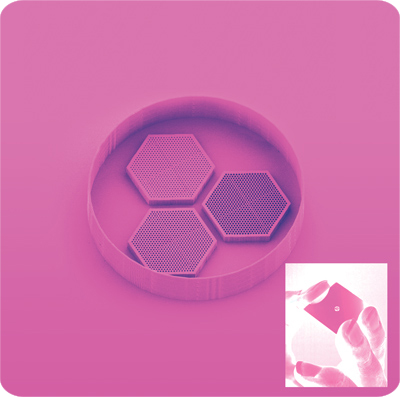 Kristan Worthington uses a 3D printer to create
cell scaffolds designed to deliver
stem cell-derived rods and cones
to the retina to help restore vision
in patients.
Kristan Worthington uses a 3D printer to create
cell scaffolds designed to deliver
stem cell-derived rods and cones
to the retina to help restore vision
in patients.
Biomedical 3D Printing: Rebuilding the Body
What I love about the recent boom in biomedical 3D printing is there are endless opportunities for positive change. As part of the mission at the UI Institute for Vision Research, my team and I use 3D printing to create materials that protect and support cells delivered to the retina. I am always inspired when I interact with patients, and it motivates and informs my daily efforts. For me, these experiences also highlight the fact that even small advances in 3D printing technology could mean a big impact in a person’s day-to-day life.
Over the next 20 years, I expect our work to improve the delivery of cell-based therapies, which are becoming increasingly common. We will also see custom 3D-printed orthopedic and craniofacial implants become the new normal, as well as an increase in the prevalence of 3D-printed model organs and tissues to study fluid and tissue behavior in the laboratory. In the next few decades, high-resolution 3D printing techniques will enhance our ability to create better biosensors and actuators for monitoring and controlling blood glucose, oxygen, or drug dosing.
When it comes to 3D printing fully functional human organs, I believe we will overcome a number of current challenges in the next 50 years. For example, we know that biological structure is important across multiple size scales. However, there is not currently a 3D printing system that can create organ-sized objects that also contain the microstructures that are often critical to proper organ function. Furthermore, we’re only beginning to realize how capable stem cells are at assembling into organs without a lot of help. Thus, I think we’ll use 3D printing to encourage or facilitate inherent cell organization rather than replace it.
If we do master the art of full organ regeneration in the next century, the possibilities are endless and the societal effects will be long-reaching. Perhaps individuals genetically pre-disposed to liver failure will have a ready-made, perfectly matched backup liver ready for their transplant instead of suffering for years while they wait for an organ donation. Maybe athletes will consider augmenting their hearts, lungs and muscles to improve performance. Imagine how lifelike an autonomous machine might be if we paired advancements in biologically-based 3D printing with progress in the field of artificial intelligence 100 years from now. Furthermore, if these systems can sense their surroundings in a realistic way, they could be used to interface with the human brain, providing endless vicarious reality experiences.
It’s almost certain that when combined with the knowledge from scientific fields such as polymer chemistry, cellular biology, and biomedical imaging, 3D printing will continue to change the way we approach human health. My one hope is that together, we approach these changes sustainably and ethically.
KRISTAN SORENSON
WORTHINGTON (13MS, 14PhD)
Assistant biomedical engineering
professor
WORK & EDUCATION

Education: Classrooms in the Digital Age
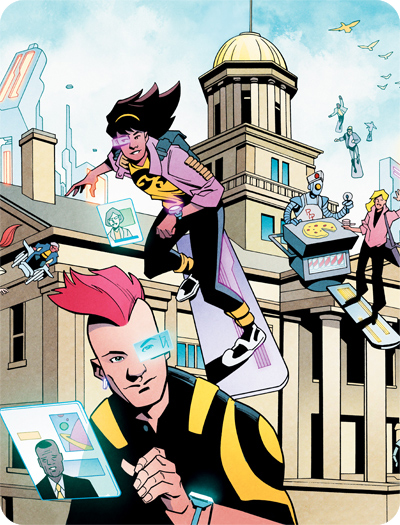 ILLUSTRATION: PHIL HESTER; ink: Ande Parks; color: Mike Spicer
ILLUSTRATION: PHIL HESTER; ink: Ande Parks; color: Mike Spicer
In the field of rhetoric and composition, we refer to the media-rich way people communicate in the digital age as multimodal communication. The classroom of the future will be a thoroughly multi-modal place. Students will express the outcomes of their learning in videos, websites, and virtual realities. Traditional papers will be replaced by media-rich texts in which students embed images, audio recordings, three-dimensional animations, and hyperlinked citations.
Classes will meet in spaces that allow for collaboration. These classrooms will offer computers, flat-panel monitors, and movable furniture, as well as microphones, cameras, scanners, 3D printers, virtual reality headsets, and other tools for digital composition. Students will video conference with experts to learn about topics. They will collaborate over distances with classes on different continents. Rather than completing exercises, they will design solutions to real problems.
If this sounds far-fetched, you may be surprised to learn that all of this is happening in today’s classrooms at the UI. Iowa Digital Engagement and Learning (IDEAL) works with faculty members who want students to engage the world beyond the classroom using digital tools and to create projects that endure beyond the semester. Rhetoric teachers also bring their students into TILE classrooms—specially designed collaborative learning classrooms where the focus is on problem solving and project-based instruction. We are teaching the rhetoricians of the future by focusing on the attitudes and flexibility that will be necessary for communicating with multi-modal technologies we haven’t yet imagined. The future we should work for is to assure that every student has the chance to learn to communicate in the most powerful and relevant media of their time.
MATTHEW GILCHRIST (04MFA)
Director of IDEAL and associate professor
of instruction in rhetoric
Education: Digital Communication
Changes to teaching will arise from a better understanding of what students need and want in a college education. Many students now attending college will wind up in jobs that do not yet exist. It will be those students’ abilities to communicate ideas effectively and persuasively across a variety of media and digital formats that will ensure their success.
Textbooks will be digital as printed works will be entirely abandoned. Immersive, virtual experiences will become popular. History students might walk through and interact with historical settings based on accurate and insightful scholarship. In much that same way books undergo new editions, these VR books might be updated in light of new research.
TOM KEEGAN (10PhD)
Head of the UI Libraries Digital Scholarship
and Publishing Studio
Work: Finding Balance
Attitudes toward work are changing in the millennial generation; they have suspicions about it being the answer to their dreams. I can’t tell you what the economic consequences of that change will look like, but work will not be the center of life. Work and leisure will lose their distinctiveness; they will become the same. The new generation is no longer interested in goods or services, but in experiences. Education will not be teaching people traditional types of work as much as teaching the skills necessary to live lives beyond the current economy and add value to experiences.
The marketplace will take the principles that positive psychologists have discovered about happiness and apply them to designing experiences as a product. This will give us a work and leisure that operate together.
BENJAMIN HUNNICUTT
Leisure studies professor
TECHNOLOGY

Karim Abdel-Malek, director of the UI Center for Computer-Aided Design and a biomedical engineering professor, forecasts advances in artificial intelligence, robotics, and virtual reality that will improve quality of life.
Robotics and Artificial Intelligence: At Your Service
Robots have become effective in manufacturing, but now they’ll do more for the consumer. Your food will be prepared and served by a robot that will also clean your dishes and house.
Our research at the UI Center for Computer-Aided Design is focused on the Virtual Soldier, a computer character used for human modeling and simulation. Imagine five years from today, the character will represent you online, predict how you feel, determine whether you’re fatigued, tell you what food you should eat, and become a counterpart to help you through life. Ten years down the line, the character can communicate with others. And imagine if we can process information from biosensors using artificial intelligence, and the machine uses it to prescribe something specifically for you. When an aging person has trouble with memory, or if someone who’s disabled needs assistance to walk—through robotics, machine learning, and artificial intelligence, we can help them.
We’re on track to advance science in AI, robotics, and virtual reality to protect soldiers, improve athletics, and help people recover faster, live longer, and live better. I’m incredibly optimistic about the future. Some people are worried that robots, VR, and AI will take jobs away, but our expectation is that for every job that will be replaced by this technology, four jobs will be created to maintain and advance it. It’s just like when computers came about—not a sudden change. It’s gradual, but it pushes us toward a better quality of life.
KARIM ABDEL-MALEK
Director of the Center for Computer-
Aided Design and biomedical
engineering professor
Finance: A Change in Money
Bitcoin is digital currency issued, run, and secured by a global network of voluntary participants. One Bitcoin in China is worth the same as one Bitcoin in the U.S. or Australia, so it’s a universal currency. Our kids aren’t going to have banks; they will have Bitcoin accounts.
Bitcoin is currently at the stage of development where the internet was in the early ’90s. It was born after the 2008 financial crisis out of frustration about corruption and lack of transparency to deliver us from the current financial system. A lot of people believe that when a government controls money, it also controls all the power and puts us in economic slavery because we’re tied to its system and can’t opt out. Bitcoin is the first time we have true, free-market competition with currencies. Just as the internet democratized knowledge, Bitcoin will democratize money, making the world of finance accessible and transparent to everybody. Bitcoin will influence everything in the financial industry: insurance, mortgages, the stock market. It will spur economic creativity and development. Its ripple effect is going to be huge—the biggest paradigm shift since the internet.
CAMERON SCHORG
UI senior from Colorado Springs,
Colorado, majoring in finance and business
information systems with a certificate
in entrepreneurial management, who
will work full-time for one of the most
influential Bitcoin companies in Switzerland
after graduation
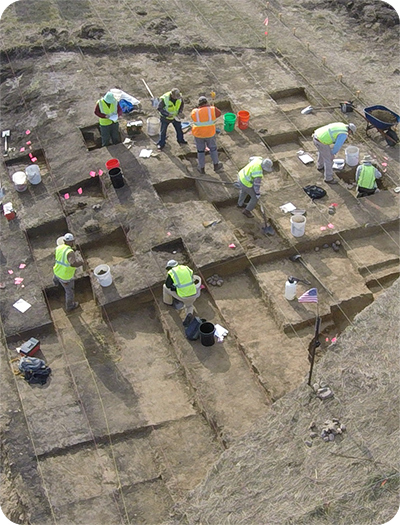 Photo: Mary De La Garza/UI Office of the State Archaeologist
A drone camera
documents an
archaeological dig
in Dixon, the site
of a former Native
American village
in Woodbury
County, Iowa.
Photo: Mary De La Garza/UI Office of the State Archaeologist
A drone camera
documents an
archaeological dig
in Dixon, the site
of a former Native
American village
in Woodbury
County, Iowa.
Archaeology: Rise of the Virtual Dig
We’re in the infancy of using cameras with drones to support state-of-the-art imaging techniques for noninvasive investigations of archaeological sites in Iowa. At the Office of the State Archaeologist, we have a drone equipped with a thermal camera that uses heat signatures to look at what lies underground without disturbing it. With this footage, we can build multidimensional models that allow archaeologists to think in different ways because now we have a bird’s-eye view.
There will be a day when we will no longer use paper reports. Instead, we’ll look at everything in a digital context and examine a site virtually.
MARY DE LA GARZA
Research technology director for the Office of the State Archaeologist at the UI
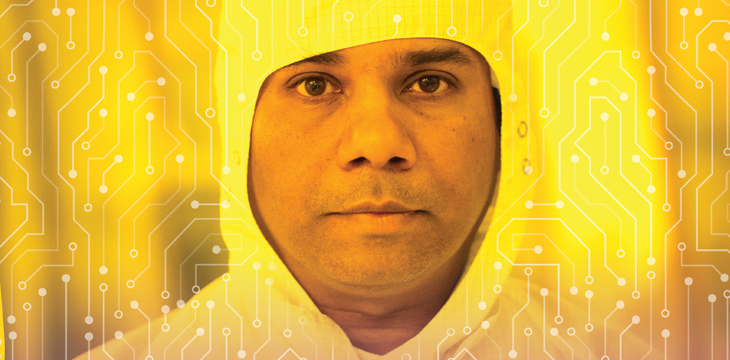 PHOTO: JUSTIN TORNER/UI OFFICE OF STRATEGIC COMMUNICATION
PHOTO: JUSTIN TORNER/UI OFFICE OF STRATEGIC COMMUNICATION
Nanofabrication: Big Idea on a Small Scale
A nanometer is a billionth of a meter, almost 100,000 times smaller than the size of human hair. We already use a wide range of technology containing features on this length-scale, such as those contained in smartphones and computers.
Our future will involve more of these devices that rely on advanced manufacturing at the nanometer-scale—particularly in the health sector where miniature devices and sensors will increase life expectancy and save lives. Imagine a future where tiny devices in our bloodstreams, powered by the energy generated by our body, act like little health workers that regulate or sense any abnormalities at the cellular levels and communicate key information in real-time to us and our physicians. Nano-scale devices also will detect the most minute hazardous environment threat to enhance human safety. One of the state-of-the-art machines located in the UI Microfabrication Facility is an electron beam lithography tool, capable of creating tiny devices for applications in electronics, optics, solar cells, and biomedical chips using a focused beam of electrons.
Although the presence of these miniature devices in almost all aspects of our lives may sound like science fiction, they will be a deep, integrated, and connected part of our lives that will enrich us in the future. Nevertheless, as with any technology, it is a double-edged sword, and we must be conscious of the applications for the good of mankind only.
AJU JUGESSUR
Director of the UI Microfabrication Facility, Optical Science
and Technology Center, and adjunct physics and astronomy professor
LEISURE

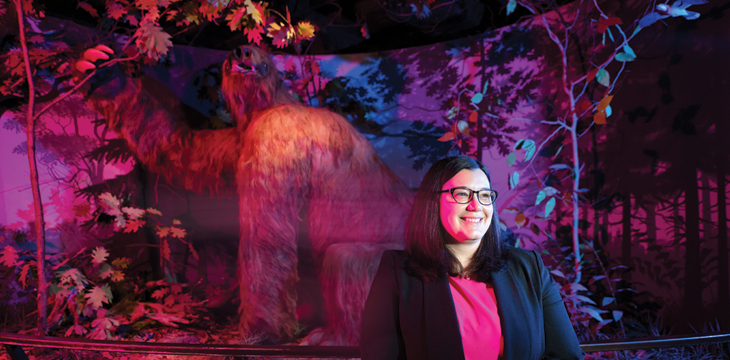 PHOTO: JUSTIN TORNER/UI OFFICE OF STRATEGIC COMMUNICATION
PHOTO: JUSTIN TORNER/UI OFFICE OF STRATEGIC COMMUNICATION
Museums: Choose Your Own Adventure
Although the majority of museums will remain grounded in our physical world, many will expand into virtual reality experiences, with some only existing in the digital world. Museums will break from their traditional modes of interpretation and communication by allowing visitors to self-curate and personalize their museum experiences. These customized initiatives will negate many of the physical, financial, societal, and emotional barriers to access that afflict museums today. By focusing on accessibility and relevance, museums will play a foundational role in supporting the larger fragmented educational system.
HEIDI LUNG
Museum studies lecturer and program coordinator
Cinema: Diversity in Storytelling
As a technologically based art form that’s only been around for 120 years, cinema naturally looks to the future. I envisage increasing experimentation with immersive cinema technologies, from 3D to virtual reality. We are already seeing new storytelling applications of VR in both fiction and documentary filmmaking, and we can expect cinema to deliver new experiences and reinventions of storytelling modes.
I also expect more media convergence between film, television, and video games, as well as a shift to watching films on small screens and via online streaming services such as Netflix and Amazon, which will continue to expand their role as film studios. However, there will also develop an accompanying appreciation for the more traditional cinema space as the premier site for watching films in all their glorious, large-screen emotional power and beauty. We will continue to see the boutique art-house cinemas (like Iowa City’s FilmScene) alongside multiplexes.
Most importantly, I believe the coming decades of cinema will see a much-needed increase in the vibrant participation of women, minorities, and voices from all over the world in what has traditionally been a white, male-dominated industry. As we all know, with the increasing accessibility of smartphones and DIY-CGI and DSLR filmmaking, entire movie studios are now in the pockets of our kids. Early exposure to the technology of cinema—coupled with a more concerted effort by the industry to promote diversity—will generate an explosion of talent, encouraging more diverse perspectives. I hope the next generation of voices to make the most inspiring, thought-provoking cinema will reflect the complex diversity of the human experience.
PAULA AMAD
Associate professor and chair of the cinematic arts department
Sports: Athletic Performance
In the past few years, we’ve incorporated GPS tracking on our athletes at practices, which allows us to accurately measure what our athletes exude during activity. All our athletes utilize recovery monitors when they wake up. They put on a chest strip, and we get immediate feedback into our computers on their heart rate variability, so it gives insight into their systematic recovery. The individualized programs we’ve designed also include force plate analysis, where athletes perform movement on a force plate for insight into their body’s symmetry, which helps us look into whether this athlete will benefit from more explosive training or from strength training.
I see it continuing to go in that direction, where we get more accurate analytical feedback from our athletes to ensure the program we design for them is the most beneficial for their performance, both in loading and recovery. The next step is bringing all the data together so we can better understand an athlete’s readiness.
CHRISTOPHER DOYLE
Head strength and conditioning coach and executive director of football
